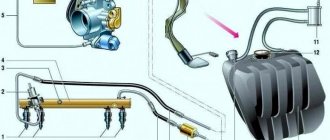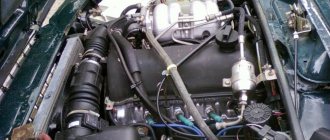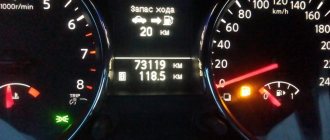A sudden, persistent smell of gasoline in the car's interior is most often a sign of a malfunction in the fuel system. This problem can be fatal under certain circumstances, and therefore it must be found and eliminated immediately. By the way, gasoline is dangerous not only because it burns well and quickly, leaving only a charred body of the car. Its vapors are also harmful, regular inhalation of which can cause dizziness, nausea, hallucinations and loss of consciousness. And an unconscious driver is a dead driver.
The car smells like gasoline after refueling.
Let's start with, perhaps, banal, but not for all obvious reasons. The first situation was when you smelled gasoline in the car after visiting a gas station where there was no gas station attendant. That is, you filled the tank with fuel yourself. In such a case, it is advisable to have some disposable gloves in the trunk so that you do not have to take the “gun” with your bare hands. Of course, no one monitors its sterility. Therefore, it is quite logical that after refueling yourself, your hands will stink of gasoline for a long time.
The second situation - there was a gas station attendant, but the circumstances were such that, in addition to the neck of the tank, gasoline also got onto its “surroundings” - on the hatch, lid, body... In such cases, even if you did not touch all of the above, the smell of gasoline may leak into the car interior through open windows.
Both situations are as banal as they are harmless. You can wash your hands, and drops and smudges of gasoline in the area of the filler neck will quickly evaporate, and will not bother you with an unpleasant odor in the cabin for a long time.
How to remove smell from the interior?
It is difficult to get rid of the unpleasant smell of fuel in the cabin. However, there are several effective methods, which will be discussed below.
Flavors
How to remove the smell of gasoline in a car for a long time? To make your car always smell nice, you can use fragrances. They come in different scents. It all depends on your preferences. They also help neutralize gasoline aroma. The main thing is not to use several scents at the same time.
Interior dry cleaning
The most effective method is dry cleaning. However, this is an expensive procedure. First, the interior needs to be vacuumed and then treated with a special solution. He will clean and disinfect the car. Afterwards, a special foam is applied and the fabric upholstery is dried.
Ozone interior cleaning
The essence of the method is to use a generator containing ozone molecules inside. They effectively remove unpleasant odors. The main advantage of ozone cleaning is the destruction of mold and bacteria. After the procedure, a pleasant smell will linger in the salon for a long time.
Shampoo wash
- Some motorists wash the interior with car shampoo.
- The product is applied to the upholstery, cleaned with a brush, and washed off with water.
- If necessary, repeat the procedure.
Soda
- First, sprinkle baking soda on the gasoline stains.
- The product must be left for 24 hours.
- Afterwards, vacuum the interior.
- Within a day the unpleasant smell will disappear.
Vinegar
This substance helps cope with unpleasant odors. Prepare a vinegar solution (1 liter of vinegar per 2 liters of water) and spray the product throughout the cabin. A spray bottle or spray bottle will help. Afterwards you need to check the car within 3-4 hours.
Coffee
An effective way to get rid of unpleasant odors in your car is to use ground coffee. Add 1 tbsp. l. on the gasoline stain and leave for 2-5 hours. Coffee contains oils that neutralize unpleasant odors.
Dishwashing liquid
If there are gasoline stains on the rugs or upholstery, you can remove them with liquid dish soap. It contains components that break down fats. Such products have a pronounced pleasant aroma that will fill the entire salon. Apply the liquid to the stain, leave until completely absorbed, and rinse with water.
Ventilation
- An effective way to eliminate unpleasant odors is ventilation.
- For safety reasons, this should be done in a garage or private yard.
- Leave the doors, trunk and hood open for several hours, or better yet, for a day.
- If there is a problem with the gas tank or its components, then this method will not help. First you need to fix the damage.
As you can see, there are many reasons for the smell of gasoline in the cabin. First you need to eliminate the cause, and then remove the smell of gasoline from the cabin.
Leaks under the hood
Gasoline leaks under the hood are already a dangerous breakdown, and until it is found and fixed, it is better not to start the engine at all. Who knows how much fuel spilled there, and where it ended up after that. A “light” that can “light” highly flammable gasoline vapors under the hood can be found at the generator, at the starter, and at the exhaust manifold.
As a rule, if the car is relatively new, the entire engine compartment fuel system is visible. To look for leaks, carefully inspect the lines and fuel filter. Gasoline especially “likes” to leak at the junctions of the pipes and fittings.
Attention! It is likely that with the engine turned off (the gasoline pump not working), you will not see any obvious leakage. Perhaps it manifests itself when pressure is created in the lines. If you suspect this reason, it is better to contact a professional. As a last resort (if your hands are itchy or there is no fear), start the engine for a short period of time and do not forget to re-read the same highlighted block above. As a rule, if there is a leak under pressure, it will quickly manifest itself. Immediately turn off the engine and only then eliminate the “weak link”.
In modern cars, finding fuel leaks under the hood is a little more difficult. At the very least, to do this you will have to remove the decorative cover and, perhaps, arm yourself with a good flashlight. While you are looking for a leak, take a sniff. Gasoline is such an infection - it gives itself away with its smell quite easily.
Under-hood problems also include fuel injectors, but more on them a little later.
How to diagnose a problem
Depending on the car model, fuel leak problems will vary. Let's look at this using the example of injection and carburetor engines.
Diagnostics of carburetor machines should be carried out with the engine running. If you check the car at idle speed, the carburetor may not allow fuel to pass through. However, when you press the gas, the pressure in the system increases significantly, which leads to a leak under the membrane. The cause may be poor bolt fastening or loose tightening.
Important! When diagnosing injection machines, you need to pay attention to the operation of the injectors. It is their malfunctions (breakage, clogging or defects) that often lead to leakage of the fuel mixture.
Depressurization of the fuel tank
If you ask experienced car repairers, they will tell you that in 95% of cases the cause of the smell of gasoline in the cabin is the fuel tank. This is not strange, since this is where the most gasoline is constantly found. Finding a gas tank leak is not an easy task. “Good” if it turns out that fuel has begun to leak somewhere in the visible part. This problem is easy to find, although not very easy, but eliminated.
It’s a completely different matter when the “dog is buried” somewhere between the tank and the body of the car. In this place, the container is pressed tightly against the machine and, according to the manufacturers’ idea, should be motionless. To prevent metal from rubbing against metal, the tank and body are separated by gaskets made of a material that tends to deteriorate over the years. When such a moment comes, it is no wonder that a literal hole appears in the tank. This is where the cabin can smell of gasoline.
Attention! If you suspect that the gas tank is leaking, you should be careful when dismantling it. Due to the fact that this part is located, to put it mildly, where it is “damp,” the fastening elements turn out to be completely rusted. They are often cut down with a grinder, which can “light” the gasoline vapors so that mom doesn’t worry.
Incomplete combustion of gasoline
Sometimes the smell of gasoline is only felt when you open the door or roll down the window. In this case, the problem may be the exhaust gases. Normally they should not have a fuel smell. If it appears, it is possible that gasoline does not burn completely, and its excess is released into the atmosphere unchanged.
The root cause of this phenomenon may be different. You will have to visit a service station and check the piston rings, spark plugs, exhaust valves, injector control unit and a number of other components and parts. The technician will conduct a comprehensive diagnosis and determine exactly where the breakdown occurred.
Fuel filler neck and cap
The filler neck in most cars is a separate part that is attached to the gas tank either with a weld or a flexible hose and clamps. During long-term use of the car, this place gradually becomes looser, and a leak may appear here. It is difficult to diagnose such a breakdown, since access for visual inspection is usually limited.
The leak itself, as such, at the junction of the gas tank and the neck may not be noticed. And all because she is not there. The ubiquitous gasoline fumes can stink. Most often, with such an “illness,” the smell intensifies (or appears only briefly) immediately after a generous dressing. There is more gasoline in the tank, and it immediately displaces the vapors that have accumulated there through a leaky connection to the neck.
The gas tank cap is not the last place to look for the source of an intoxicating odor. This part is equipped with a sealing gasket, which, like everything else in the machine, is not made from durable materials. When it rots, gets lost, breaks, and so on, the smell of gasoline doesn’t take long to appear.
Many novice car owners mistakenly believe that there is a small hole in the gas tank cap, which is designed to relieve excess pressure. Gasoline in a tank can indeed expand significantly in the summer, as can its vapor. But the vapors do not escape through any hole in the lid (due to its absence there). And all because for these purposes brilliant car makers invented...
Oil smells like gasoline: reasons
Motorists for the most part, as a rule, never pay attention to the smell of oil. And it may smell like gasoline. You need to know that if such a smell appears, then it is necessary to establish the cause of its occurrence. Since this indicates that, with a high degree of probability, a malfunction has appeared in the car’s engine.
The essence of the problem
In a healthy engine, the lubrication system in which oil circulates is isolated from the fuel system. As a result, gasoline cannot penetrate the oil. However, if this happens, the oil dipstick will emit a gasoline smell (the oil smells like gasoline).
If the driver does not trust his sense of smell, then the presence of gasoline on the dipstick is determined quite simply. To do this, you need to move a sufficient distance away from the car and apply an open flame to the dipstick using a lit match or lighter. The presence of gasoline is indicated by a flash, while pure oil will ignite very slowly.
Auto mechanics, as well as experienced car enthusiasts, advise checking the oil level once a week. Systematic and ongoing checks will reveal a decrease in engine oil level. And also assess its condition.
If the oil is within acceptable limits, but its color and consistency have changed, an odor has appeared, and the oil smells like gasoline, then these are signs indicating the need to diagnose the internal combustion engine.
Gasoline can appear in the oil even in an engine that has a perfectly serviceable cylinder-piston system. However, if the engine oil smells like gasoline, then this is considered a serious problem. It can lead to malfunctions of the motor, reduce its service life, and also lead to complete breakdown.
When gasoline gets into the oil, it begins to lose its properties and becomes more liquid. The more gasoline that has entered the oil sump, the more significant the damage will be.
The main signs of the appearance of gasoline in oil
Experts include the following signs indicating a problem with fuel penetration into the lubricant:
- The engine begins to lose power, and fuel consumption increases noticeably.
- The exhaust system produces gray and thick exhaust that smells of gasoline.
- The engine begins to malfunction, stall, and periodically stall.
- The engine operation has become noticeably louder, knocking noises are recorded in the piston system, in the area where the crankshaft and other engine components are located.
- The oil dipstick shows that there is more oil in the crankcase, the engine oil smells like gasoline, which is clearly noticeable.
- The oil has become more liquid; a drop of it from the dipstick easily ignites from an open fire.
Method for checking oil quality
There is a way to check the quality of the oil. It is also used when checking for the presence of gasoline in it. The method is called "Oil Slick". When using it, one drop of oil from the dipstick is dripped onto a sheet of paper. The paper is dried for about 2 hours.
If the edges of the spreading drop are smooth, this indicates that the oil has not lost its properties. A black outline in the central part of the spot indicates that the lubricant contains effective additives.
This method is used to assess the quality of the oil and determine the presence of other inclusions in it, including water and gasoline.
It is worth understanding that fuel (gasoline) is an aggressive product towards oil. It includes a significant number of different chemical additives and additives. Engine oil also has additives, and they should not come into contact with the fuel.
If contact between gasoline and oil does occur, then it should be understood that irreversible changes in the physical and chemical parameters of the engine lubrication occur.
As a result, if the oil level in the crankcase increases due to fuel getting there, this is a serious threat to the car’s engine.
But why does oil smell like gasoline? To answer this question, you need to understand how it gets there.
THIS IS INTERESTING: How long does a psychiatric examination last?
Ways gasoline gets into oil
To understand why gasoline penetrates into the engine lubricant, you need to understand the design of the internal combustion engine.
- The main way gasoline enters the engine crankcase from the combustion chamber (on both injection and carburetor engines) is through the piston rings. Quite often gasoline gets into the crankcase on new engines. When the piston rings are not yet ground in, there are leaks in the cylinders.
- Engines equipped with a carburetor have a weak link - this is the fuel pump diaphragm. If it is deformed or has another defect, then gasoline will definitely penetrate into the engine lubricant. Other causes include problems with the carburetor needle valve, float chamber valve, fuel overflow, etc.
Causes of oil contamination by fuel
It follows from this that the main reason for diluting oil with gasoline is problems in the power and ignition system or in the engine itself. Having systematized all the reasons, you can get the following picture:
- the working fuel mixture is over-enriched;
- faulty injectors, carburetor, fuel pump;
- there are malfunctions in the ignition system, it does not work correctly;
- the engine is worn out, there is no compression in the cylinders, fuel does not ignite.
Due to the above reasons, fuel is supplied to the combustion chamber in excess. This causes it to become over-rich and unable to ignite. The fuel does not burn, including due to the lack of a spark on the spark plugs or due to low compression.
Fuel that is not burned enters the oil sump.
In any case, if fuel penetrates into the oil, it is not recommended to operate the engine until the causes are determined and the problem is eliminated. This is especially dangerous if the driver is unaware of the problem and a significant amount of fuel has accumulated in the crankcase. The pressure in the lubrication system drops, the dashboard signals an emergency condition of the oil pressure.
In such a situation, immediate action must be taken to eliminate the underlying problems. This is done at service stations that repair the ignition system, carburetor, and injection. You will definitely need to change the oil and oil filters. If after this there are no signs that the engine oil smells like gasoline, the cause has been eliminated.
Fuel pump malfunction
In a car that is equipped with a mechanical fuel pump, its diaphragm pumps gasoline directly into the carburetor. However, if it is damaged or torn, fuel makes its way into the rod channels. The pump rod is driven by an eccentric, which also participates in the distribution of oil in the engine. Therefore, gasoline easily finds its way into the oil environment. You can determine this problem by smelling the smell of fuel on the dipstick (the oil smells like gasoline).
If the damage to the diaphragm is minor, the lubricant level may remain the same for a long time. However, if there are significant gaps, gasoline no longer enters the carburetor in the required quantities, the car starts with difficulty, and its movement occurs jerkily. Usually the malfunction is eliminated by replacing the diaphragm with a new one, included in the standard fuel pump repair kit.
If during the inspection after repair it is not determined that the engine oil smells like gasoline, then the problem has been solved.
Injector malfunction
If the engine is a fuel injection system and if the oil smells like gasoline, the reason is that there is a problem with the injectors or the ignition system. Nozzles, one or more, do not provide a tight seal. After the engine is turned off, fuel, due to residual pressure, penetrates into the manifold and then into the cylinders. If the piston rings are not worn out, then gasoline will not get into the crankcase.
But if they have been in use for a long time, if the rings are stuck, then they will not be able to prevent gasoline from flowing into the oil sump. To eliminate this problem, it is recommended to remove the fuel rail and check each injector for leaks. At the same time, kerosene or a special liquid from aerosol cans is supplied to them under pressure.
If the injectors are leaking, as well as damage to the spark plugs, they are replaced with serviceable ones.
Piston system malfunction
Eliminating this problem is considered the most expensive and difficult. This malfunction usually occurs if low quality oil and gasoline are used. Low-grade fuels and lubricants cause the piston rings to become coked. Fuel begins to leak through the gaps that appear between the piston and the cylinder walls. Then it gets into the oil sump.
To identify this malfunction, you will need to use a compressor. They measure data on the compression of the cylinders, each individually. If the readings differ by more than ten percent from the established standards, this indicates a malfunction.
Piston rings that are susceptible to coking are washed with chemicals specially designed for this purpose. An oil change after such a procedure is mandatory. Usually the engine oil does not smell like gasoline after this procedure.
If flushing the cylinder block does not help, which happens infrequently, then the engine is disassembled to replace faulty rings and pistons.
Poor quality fuel
Sometimes the cause of incomplete combustion of the fuel mixture in the cylinders is the gasoline itself. It is not uncommon that the quality of fuel at gas stations leaves much to be desired. Moreover, gasoline may be mixed with other additives that make it more difficult to ignite. Unburned fuel mixture residues penetrate into the engine crankcase. In these cases, to fix the problem, you need to start using another gas station, but you will still have to change the oil.
Some experts advise, as a preventative measure, when driving on open roads, to allow the engine to run for a short time at high speeds. This type of driving leads to higher oil temperatures. This reduces the amount of condensate accumulated in the lubricant and gasoline entering the oil.
Read US on VKontakte
Source: https://365news.biz/avto/151890-maslo-paxnet-benzinom-prichiny.html
This post has 1 .
:
- Causes of the smell.
- The injectors are to blame.
- The piston system is faulty.
Many car owners periodically encounter the fact that the oil dipstick smells of gasoline. Since the acuity of smell is different for everyone, knowledgeable car enthusiasts advise performing one simple additional manipulation: move away from the car and try to hold the probe over the flame of a lighter.
If the sense of smell does not fail and there are gasoline residues on the dipstick, a small flame will appear, indicating that the fuel vapor has burned out. You can go the other way, without using a lighter: place a drop of oil on a clean sheet of paper with the tip of a dipstick. If there is gasoline, a droplet begins to spread across its diameter, wetting the paper.
If there is no gasoline, the oil remains in its original form, its viscosity will not allow the drop to spread and wet the paper base.
Why does my dipstick smell like gasoline?
Possible reasons: mechanical fuel pump is faulty; faulty injectors or faulty piston system. In the first case, the fuel pump is removed and gasoline is pumped manually using the pumping lever.
Smudges appearing on the engine wall or a sharply increasing smell of gasoline is evidence that the fuel pump diaphragm has lost its tightness.
There are two ways to fix this problem, one of which is quick, but gives a short-term effect, this is adding several layers of cellophane to the diaphragm. And a more reliable option is to replace the fuel pump with a new one.
The cause of the smell may be a malfunction of the piston system.
Repairing this problem is the most expensive and difficult. And most often this problem occurs when using low quality oil or fuel. Poor-quality lubricant and fuel products lead to coking of the piston rings, as a result of which fuel evaporates through the gaps formed between the piston and the cylinder walls and enters the oil.
To identify this problem you will need a compression gauge. A compression meter measures the compression of each cylinder. A difference of more than 10% from the standards specified by the manufacturer indicates a malfunction. Coked piston rings are washed with chemicals specially designed for this purpose, after which an oil change is required. In rare cases, flushing does not help, then the engine is disassembled and the faulty pistons are replaced.
Source: https://autonovice.ru/maslyanyy-schup-pahnet.htm
Absorber and company...
The absorber is a whole structure, which is designed to prevent expanding fuel and its vapors from inflating or rupturing the gas tank. But environmentalists and other “greens” do not allow gasoline vapors to be released into the atmosphere just like that. They “forced” the designers to introduce things into cars that could purify gasoline vapors and not cause irreparable harm to the environment.
The structure of the classic absorber is very simple. This is a plastic or metal box, inside of which there is a carbon (usually) filler that acts as a filter. Gasoline vapor from the tank enters here through a tube that fits onto the fittings.
The absorber can become the “culprit” of the smell in the car interior for several reasons:
- the carbon filter has already served its purpose;
- there is a leak at the hose connection points;
- for some reason the branch pipe of the ventilation branch has become bent and no longer allows vapor to pass through it;
- blockage in the gas tank ventilation system.
This problem is quite easy to diagnose and fix. It is quite possible to do without specialists. You should look for the absorber somewhere in the lower rear part of the car near the gas tank itself. In some cars it is “hidden” under the wing. The part is dismantled, cleaned, washed, checked for leaks and reinstalled. If after dismantling it becomes obvious that it will not work, replace it.
Inattentive gas station worker
Another reason is that the gas station worker does his job poorly, and drops of gasoline fall on the rear wheel of your car and on the body. If it's one or two drops, there shouldn't be any problems. But if the entire wheel is flooded with fuel, rear seat passengers will complain. They will likely smell a strong odor until the gasoline has completely evaporated.
What you can do is visit your nearest car wash and wash your rear wheel using effective shampoos. Or simply pour a large amount of water onto the wheel.
Fuel level sensor in the tank and fuel pump
It is a float connected to a banal ohmmeter. When there is more gasoline in the tank, the float rises, the resistance of the ohmmeter decreases, and the arrow on the instrument panel gives the owner an incomparable feeling of joy.
So, this sensor is attached directly to the gas tank and is sealed with a gasket. In some cars, the fuel level sensor is integrated into the tank in a single module with the fuel pump. One way or another, if the part is poorly secured or installed on a bad gasket, the smell of gasoline in the cabin cannot be avoided.
Problems with EVAP
The last reason that came to our mind is the EVAP system. A harmful gas emission control system is installed in many modern cars. One part of this system is a canister with a carbon filter. If it cracks, fuel will leak out of the car and give off an unpleasant odor.
The EVAP system can be located in different parts of the car, so it is better to check the location in the instructions or on forums on the Internet. A cracked canister should be replaced as soon as possible, as leaks can lead to fires and explosions.
Unsuccessful fuel system repair
Many “would-be masters” try to fix the fuel system using sealant, epoxy resin, cold welding and other “plasticine”. Oh yes, sometimes various “superglues” are used. Remember once and for all: gasoline is an excellent solvent, and sooner or later it destroys all these putties. If the fuel system was repaired with the help of these “plantains”, if you smell gasoline in the cabin, first of all, inspect the places of such “repairs”. Unfortunately, even professional craftsmen at decent service stations do not hesitate to use them.
Let's sum it up
The smell of gasoline in the cabin is not a reason to panic, but also not a reason to turn a blind eye to it. Perhaps the reason is trivial and you can fix it yourself. But it also happens that there is a smell of gasoline due to serious malfunctions of the fuel system components. It’s better to play it safe and make sure after diagnostics that everything is fine, rather than spending money on repairs and purchasing spare parts.
Do not trust your car to garage technicians and do not try to determine the cause of the smell if you are not very well versed in the “stuffing” of the car. Entrust this work to car service specialists - they will do everything quickly and efficiently, using high-quality spare parts, and will also provide you with a guarantee for all work.
Junk in the luggage compartment
We started with a triviality that was not obvious to everyone, and we’ll end with it. If nothing helps get rid of the persistent smell of gasoline in the car, look carefully in the luggage compartment. Perhaps there is a canister or bottle of fuel lying around, a rag that you use to wipe parts washed in gasoline, and so on. For an avid fan of turning nuts with his own hands, even his wrenches are “throughly soaked” in gasoline...
In addition to the smell of gasoline, there may be other foreign odors in the car interior, for example, a musty smell, the smell of mold or rot.
Faulty catalyst
The task of the catalytic converter is to burn off the fuel vapor remaining in the exhaust gases. To do this, it must heat up to operating temperature, which on average ranges from 600 to 800 degrees. This takes time. Therefore, in the first minutes after starting the engine, the catalyst is simply not able to clean the exhaust. In this case, a slight smell of gasoline is normal.
If this is observed with a heated catalyst, it is necessary to check its condition. In case of burnout, the element will have to be replaced with a new one.
By the way, many drivers get rid of catalysts altogether.
Air conditioner
The air conditioning or climate control system requires regular maintenance. You can, of course, wait until the last minute. A musty smell when you turn on the cooling mode will quickly remind you that it’s time to service the air conditioning system for antibacterial treatment. Delaying it, by the way, is fraught with illnesses for the driver and passengers: the depths of the system eventually become a breeding ground for fungi and bacteria.
Don’t forget about timely replacement of the cabin filter. It might smell too. Although, as a rule, this element is capable of moving 15,000 km even in the conditions of a Russian metropolis.











